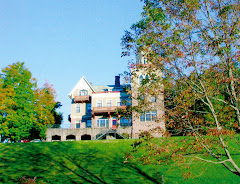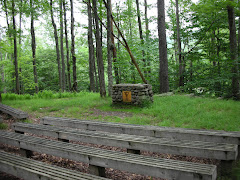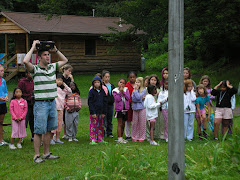Pigeon has always been my favorite stream here, and it has some serious competitors.
There's the stateliness and historical significance of the main river flowing through our land - the Neversink, a mecca for flyfishermen starting with the Dutch in probably the 17th century - a classic.
High Falls Brook above the falls itself is a lot like Pigeon, actually, but below it it's slower, wider, more "obvious" than Pigeon. And it has a reason for going: High Falls. Forgive me for putting it this way, but it's like a tourist-destination stream. Not for me when I want the real thing. I've climbed up all the way along High Falls Brook to its source, up a ridge of Doubletop and is probably the best way these days to get up Doubletop. So H.F.B. is special to me but still there's that hike-a-little get-big-payoff thing that seems facile. Hemlock Brook aka Trickle Creek isn't really much and it runs right through the middle of camp, so it hardly counts, and it's dry a lot of the year. It does, when it's been raining a lot, go through the middle of Big Tree Field and that's a nice feature.I don't know if the stream that once flowed through the meadow that is now Lake Cole ever had a name. I suspect not. Two or three streams feed the man-made lake. Anyway, that can't count, can it?
The East Branch of the Neversink flows down the back side of slide, picks up real stream status through the Tison preserve (Frost Valley land), then passes right next to the old Straus estate (now East Valley Ranch, also FV), passes across the road from our Farm Camp (where the kids actually have their "waterfront" period in one of its deep-ish holes) and flows all the way to Claryville, where, just at the famed turn-off to county road 47 and the 7 miles to Frost Valley's main property, the two branches of the early Neversink converge. I love the East Branch and it's getting to be one of those rivers I can drive next to and feel lots of feelings. For one thing, as I drive alongside it toward and at the Tison property, near the head of the Denning trail, I can fool myself into believing that I'm existing in 1870 or 1890.
Biscuit Creek - she's got to be at least everyone's second favorite. Biscuit is what you think of when you think of this part of the Catskills. Really gorgeous. Moves slowly and knows where it's going. Flumes here and there cut through the glacial boulders - making mesmerizing features such as Devil's Hole. It's easy to hike alongside. The train dates back at least to Forstmann's time, when he laid down felled Hemlock trunks on the creek-side edge of the trail, and rode big horses pretty far down the river. I think of Biscuit Creek as Forstmann's stream. The storm messed with Biscuit down near the open fields of camp and down to where it joins the Neversink. Damage upstream is not so horrid. It still looks like Biscuit. (Above: Biscuit Creek falls a few years ago.)
But Pigeon Brook. It's crazy and it's wild. It drops from around 3750 feet at its 2-pronged source, up near the top of of Doublestop, to the spot (right at Sequoia) where it meets its calm brother Biscuit at around 2000 feet (the bottom of our valley is 1900 feet). That's a steep drop. The Pigeon Brook valley, formed between (and actually dividing) Doubletop Mountain and Big Indian Mountain, is very steep. Thousands of years of erosion and this little feisty waterway has done most of that deepening. At right above you can see a Google Map version of the first part of Pigeon. See where Biscuit, much thicker blue, goes off to the east or right. That's Pigeon, ending at Sequoia, bending up off to the west or left and then turning north and up the mountain. Below you see a satellite photo of roughly the same sector: again, Pigeon off to the left, Biscuit to the right. Pigeon goes almost due north up the mountain. That accounts, of course, for its sections of steep descent.
Yesterday - the Saturday of holdover weekend between sessions 2 and 3 - was the perfect day for a hike up Pigeon. At least by the calendar. By the weather, not so much. An hour into our 5-hike hike up and back it started pouring, and I mean pouring. I hadn't brought rain gear because - what the hell. I knew I'd be scrambling hand and foot up the creek itself much of the time and so I'd be very wet anyway. So I put on non-cotton shirt and shorts no hat and headed out. Along with Dr. Rick Kaskel (another trustee and long-time dialysis doctor and a guy with a replaced hip!) and Bud Cox, who got persuaded to do this hike right there over breakfast, a few minutes before departure. Good ol' Bud. Of course having Bud with us meant that we had
Banks are eroded everywhere, which means that any chance of forging a trail or path along either side of the stream becomes less likely. And everything is soft or crumbly underfoot.
Here, below, Bud shows where the waterline was at the height of the storm's violent run-off. This we figured by looking hard at damage, water marks, and erosion. Amazing, eh? When the water was really this high, the entire Pigeon Brook valley was filled with fast-moving water. No wonder the pressure below was so great - on the Biscuit Creek falls in camp, on the bank keeping Pigeon Lodge up out of the stream, on the spot where Biscuit (which Pigeon's water in it) slammed against the southside bank of the Neversink behind the horsebarn.
In the pouring rain, fairly well exhausted from the scrambling ascent on hand and foot in the middle of the brook, climbing over many fallen trees and slipping on tilty rocks that had only been in place for 11 months, we reached the Pigeon Brook fork. Here two feeder streams converge to form Pigeon proper. One goes up and east toward Big Indian Mountain. The other goes up and west toward Doubletop. We went on the northwest fork for a little, then clambered up the steep slope and took a compass bearing west to try to find the deerpath that comes due south down from the top of Doubletop. We didn't get that far and in the pouring rain abandoned the plan to continue to the top of the mountain - and headed at a bearing of 255 degrees. Bushwacked, of course, keeping the Pigeon Valley to our left and staying on a 2500 feet contour for quite a while. Eventually we descended on the same contour and at 2200 feet cross the Frost Valley property line and headed due south into camp. We read the perimeter trail and walked by into camp just to the east of Friendship House and Wolff Lodge. (I add these details in part so others can repeat the trip with some relatively specific instructions.) Dear FV-loving reader of this blog: get thee up Pigeon Brook. What are you doing with your life that you can't spare a day and do this? It's good for the soul: rough hard work, and it fills a longing that camp people have felt every since Wawayanda moved here in 1958, but a somewhat lost art. Go there and be real.


















